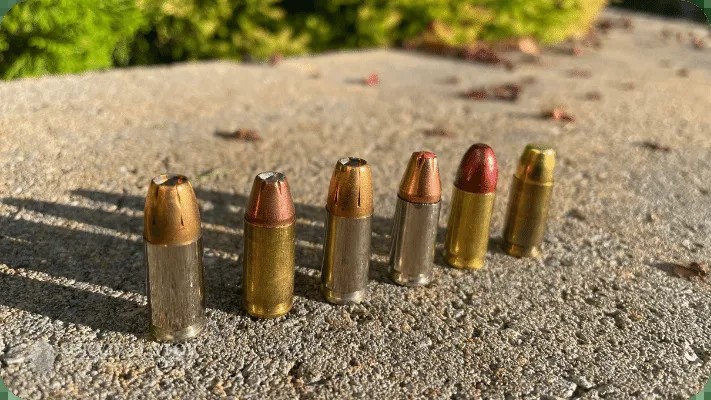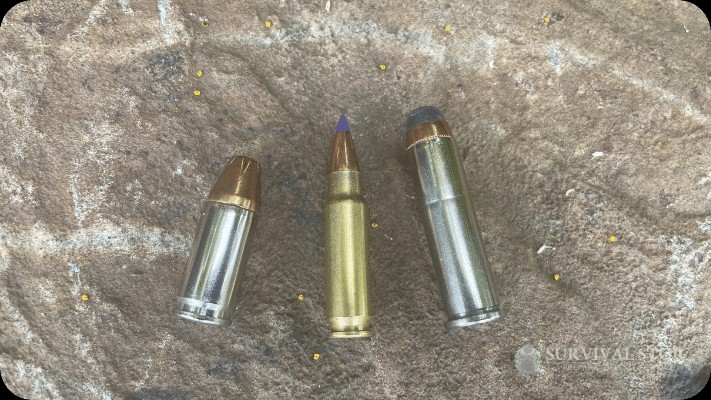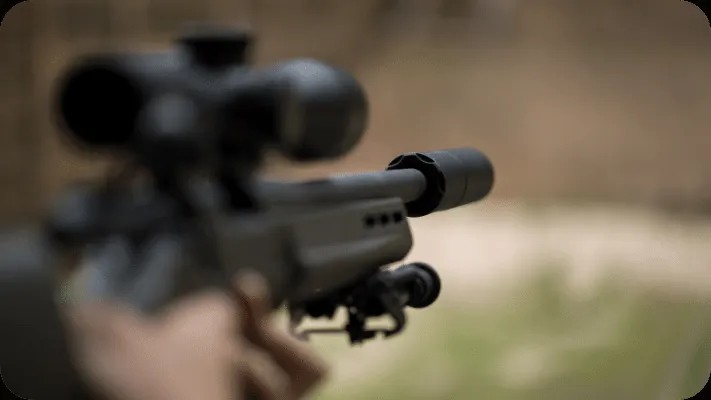Are you curious about how fast a 9mm bullet travels and what factors influence its speed? At SIXT.VN, we understand the importance of accurate information, whether you’re a shooting enthusiast or simply interested in ballistics. This guide dives deep into the velocity of 9mm rounds and the elements that affect their performance, offering insights to enhance your understanding. Let SIXT.VN be your trusted companion, providing reliable and informative content tailored to your interests.
1. What is the Average Speed of a 9mm Bullet?
The typical 9mm bullet travels at approximately 1,150 feet per second (fps), equivalent to 784 miles per hour (mph). However, this speed can vary based on several factors, including bullet weight, powder load, and barrel length.
 Various 9mm cartridges
Various 9mm cartridges
Alt text: Assortment of 9mm ammunition cartridges demonstrating different bullet types and casings.
2. What Factors Influence the Speed of a 9mm Bullet?
Several factors can affect how fast a 9mm bullet travels. Understanding these elements can help you make informed decisions about ammunition selection and firearm choice.
2.1. Bullet Weight
The weight of the bullet significantly impacts its speed. Heavier bullets generally travel slower than lighter bullets, assuming all other factors remain constant.
2.2. Powder Load
The amount of gunpowder in the cartridge directly influences the bullet’s velocity. Higher powder loads typically result in faster speeds, which are often indicated by “+P” or “+P+” designations on the ammunition.
2.3. Barrel Length
The length of the firearm’s barrel affects the amount of time the expanding gases from the burning powder have to propel the bullet. Longer barrels generally result in higher muzzle velocities.
2.4. Ammunition Type
Different types of 9mm ammunition are designed for various purposes, such as self-defense, target shooting, or competition. These different designs have a huge impact on the speed of a 9mm bullet.
2.5. Environmental Conditions
While not as significant as other factors, environmental conditions such as temperature and altitude can slightly affect bullet speed due to changes in air density and pressure.
3. How Does Bullet Weight Affect 9mm Speed?
Bullet weight is a critical factor in determining the speed of a 9mm bullet. Here’s a more detailed look:
- Lighter Bullets: These bullets, typically ranging from 90 to 115 grains, can achieve higher velocities. They often produce less recoil, making them easier to control for some shooters.
- Medium-Weight Bullets: Bullets in the 124 to 135-grain range offer a balance between speed and energy. They are a popular choice for self-defense and general-purpose shooting.
- Heavier Bullets: Ranging from 147 to 150 grains, heavier bullets tend to have lower velocities but can offer better penetration and energy transfer. They are often used in subsonic loads for suppressed firearms.
4. What is the Impact of Powder Load on 9mm Velocity?
The amount and type of gunpowder used in a 9mm cartridge significantly affect its velocity.
- Standard Loads: These are typical factory loads designed to meet SAAMI (Sporting Arms and Ammunition Manufacturers’ Institute) specifications.
- +P Loads: These cartridges contain more powder than standard loads, resulting in higher pressures and velocities. They are designed for increased stopping power but may produce more recoil and wear on the firearm.
- +P+ Loads: These are even higher pressure loads than +P, offering even greater velocities and energy. However, they should only be used in firearms specifically rated for +P+ ammunition due to the increased stress on the gun.
5. How Does Barrel Length Influence 9mm Bullet Speed?
The length of the firearm’s barrel plays a crucial role in determining the velocity of a 9mm bullet.
- Shorter Barrels (e.g., 3-4 inches): Commonly found in compact and subcompact pistols, shorter barrels result in lower velocities due to the shorter time the bullet is exposed to the expanding gases.
- Mid-Length Barrels (e.g., 4-5 inches): These barrels offer a balance between concealability and velocity, making them a popular choice for concealed carry pistols.
- Longer Barrels (e.g., 5+ inches): Typically found in full-size pistols and pistol-caliber carbines, longer barrels allow for greater velocities and improved accuracy.
 The author
The author
Alt text: A selection of 9mm, 5.7 x 28, and .357 Magnum bullets displaying different bullet shapes and sizes.
6. What is the Velocity Range of Different 9mm Ammunition Types?
9mm ammunition comes in various types, each with its own velocity range:
| Ammunition Type | Bullet Weight (grains) | Muzzle Velocity (fps) | Muzzle Velocity (mph) |
|---|---|---|---|
| Standard FMJ | 115 | 1150 | 784 |
| +P Hollow Point | 124 | 1200 | 818 |
| +P+ Hollow Point | 115 | 1300 | 887 |
| Subsonic FMJ | 147 | 950 | 648 |
| Competition Load | 115 | 1100 | 751 |
| Frangible Ammunition | 100 | 1400 | 955 |
7. How Does 9mm Speed Compare to Other Calibers?
Understanding how 9mm speed compares to other common calibers can provide valuable context.
- .22 LR: This rimfire cartridge typically travels at around 1,070 fps (730 mph), making it slower than most 9mm loads.
- .40 S&W: The .40 S&W generally travels at around 1,020 fps (695 mph), slightly slower than standard 9mm loads but often with a heavier bullet.
- .45 ACP: The .45 ACP typically travels at around 886 fps (604 mph), significantly slower than 9mm but with a much larger and heavier bullet.
- 5.56 NATO: This rifle cartridge travels at around 3,180 fps (2,168 mph), making it much faster than 9mm due to its larger powder capacity and longer barrel lengths.
8. Why Does 9mm Bullet Speed Matter?
Bullet speed is an important factor to consider because it directly impacts several key aspects of the bullet’s performance. These include:
- Energy Transfer: The kinetic energy of a bullet is directly related to its mass and the square of its velocity. A faster bullet will generally deliver more energy to the target, potentially resulting in greater stopping power.
- Trajectory: Higher velocity bullets tend to have flatter trajectories, meaning they drop less over distance. This can make them easier to aim and more accurate at longer ranges.
- Penetration: While not solely dependent on speed, a faster bullet can often penetrate deeper into a target than a slower bullet, assuming similar bullet designs and construction.
9. What Are Some Examples of High-Velocity 9mm Ammunition?
Several manufacturers offer high-velocity 9mm ammunition designed for specific purposes. Some notable examples include:
- Federal Premium HST +P: Known for its consistent expansion and reliable performance, this load achieves velocities around 1,200 fps with a 124-grain bullet.
- Speer Gold Dot +P: Another popular choice for self-defense, this load offers high velocities and excellent terminal performance with a 124-grain bullet.
- Underwood Ammo Extreme Defender: Featuring a unique bullet design, this load achieves very high velocities and is designed for deep penetration.
10. What are Subsonic 9mm Bullets and Why Use Them?
Subsonic 9mm bullets travel at speeds below the speed of sound (approximately 1,128 fps or 767 mph). These bullets are often used in conjunction with suppressors to reduce the noise signature of the firearm.
 The author showing a rifle suppressor
The author showing a rifle suppressor
Alt text: Close-up of a rifle suppressor attached to the end of a rifle barrel for sound reduction.
10.1. Benefits of Subsonic 9mm Ammunition
- Reduced Noise: By traveling below the speed of sound, subsonic bullets eliminate the sonic boom, making the firearm quieter when used with a suppressor.
- Less Recoil: Subsonic loads typically have lower powder charges, resulting in reduced recoil, which can improve shooter control and accuracy.
- Specialized Applications: Subsonic ammunition is often used in tactical applications where minimizing noise is critical.
11. How Do I Choose the Right 9mm Ammunition for My Needs?
Choosing the right 9mm ammunition depends on several factors, including your intended use, firearm type, and personal preferences.
11.1. Intended Use
- Self-Defense: Look for hollow-point ammunition with a good reputation for expansion and penetration. +P loads may offer increased stopping power, but consider the increased recoil.
- Target Shooting: Full metal jacket (FMJ) ammunition is typically the most economical choice for target practice.
- Competition: The best ammunition for competitions is whatever will give you the best score. You want something accurate and reliable.
- Hunting: Use the right tool for the job. While 9mm bullets can be used for hunting it is not ideal and you should be limited to small game.
11.2. Firearm Type
- Compact Pistols: Shorter barrels may not fully utilize the potential of +P ammunition. Standard loads or lighter bullets may be a better choice.
- Full-Size Pistols: These pistols can handle a wider range of ammunition types, including +P loads.
- Pistol-Caliber Carbines: Longer barrels can maximize the velocity of 9mm ammunition, potentially increasing its effective range and energy.
11.3. Personal Preferences
- Recoil: Some shooters are more sensitive to recoil than others. If you are recoil-sensitive, consider lighter bullets or standard loads.
- Accuracy: Experiment with different ammunition types to see which ones perform best in your firearm.
- Reliability: Choose ammunition from reputable manufacturers with a track record of reliability.
12. The Importance of Ballistic Testing
Ballistic testing is the process of measuring the performance of ammunition, including its velocity, accuracy, and terminal effects. This testing can provide valuable insights into how different ammunition types perform in real-world scenarios.
12.1. Chronographs
A chronograph is a device used to measure the velocity of a bullet as it exits the barrel of a firearm. It uses two light sensors set at a known distance apart and calculates the speed based on the time it takes the bullet to pass between the sensors.
12.2. Gel Testing
Ballistic gel is a standardized medium used to simulate the effects of a bullet impacting tissue. Gel testing can provide information on bullet expansion, penetration depth, and overall terminal performance.
12.3. Real-World Testing
While laboratory testing is valuable, real-world testing can provide additional insights into how ammunition performs in different environments and scenarios. This may include testing in different weather conditions or against various types of barriers.
13. Common Misconceptions About 9mm Bullet Speed
There are several common misconceptions about 9mm bullet speed that should be addressed.
13.1. Faster is Always Better
While higher velocity can increase energy transfer and flatten trajectory, it is not always the most important factor. Bullet design, expansion, and penetration are also critical considerations.
13.2. All 9mm Ammunition is the Same
As discussed earlier, 9mm ammunition comes in a wide variety of types, each with its own unique characteristics and performance profile.
13.3. +P Ammunition is Always Necessary
+P ammunition can offer increased stopping power, but it is not always necessary. Standard loads may be sufficient for many self-defense scenarios, and +P ammunition may produce excessive recoil in some firearms.
14. How to Improve Your Accuracy with a 9mm Firearm
Improving accuracy with a 9mm firearm involves a combination of factors, including proper technique, consistent practice, and selecting the right ammunition.
14.1. Proper Grip
A firm, consistent grip is essential for controlling recoil and maintaining accuracy.
14.2. Sight Alignment
Proper sight alignment involves aligning the front and rear sights so that they are in focus and centered.
14.3. Trigger Control
Smooth, consistent trigger control is critical for avoiding jerking the firearm and disrupting your sight picture.
14.4. Practice
Regular practice is essential for developing and maintaining your shooting skills.
15. Safety Precautions When Handling 9mm Ammunition
Handling 9mm ammunition safely is essential for preventing accidents and injuries.
15.1. Store Ammunition Properly
Store ammunition in a cool, dry place away from heat and moisture. Keep it out of reach of children and unauthorized individuals.
15.2. Wear Eye and Ear Protection
Always wear eye and ear protection when shooting to protect yourself from flying debris and loud noise.
15.3. Handle Firearms Responsibly
Treat every firearm as if it is loaded. Never point a firearm at anything you are not willing to destroy. Keep your finger off the trigger until you are ready to shoot.
16. The Future of 9mm Ammunition Technology
9mm ammunition technology continues to evolve, with manufacturers constantly innovating to improve performance and address emerging needs.
16.1. New Bullet Designs
New bullet designs are constantly being developed to improve expansion, penetration, and overall terminal performance.
16.2. Advanced Propellants
Advanced propellants are being developed to increase velocity and reduce recoil.
16.3. Lead-Free Ammunition
Lead-free ammunition is becoming more popular due to environmental concerns and regulatory requirements.
17. Vietnam Awaits: Let SIXT.VN Enhance Your Journey!
Planning a trip to Vietnam? Let SIXT.VN handle all your travel needs, ensuring a seamless and unforgettable experience. From airport transfers to hotel bookings and exciting tours, we’ve got you covered.
17.1. Explore Hanoi with Ease
Discover the beauty and charm of Hanoi with our expertly curated tours. Our friendly and knowledgeable guides will take you to the most iconic landmarks and hidden gems.
17.2. Comfortable Airport Transfers
Start your trip stress-free with our reliable airport transfer services. We’ll ensure you arrive at your hotel safely and comfortably.
17.3. Convenient Hotel Booking
Choose from a wide range of hotels that suit your budget and preferences. We offer hassle-free booking with the best rates guaranteed.
17.4. Unforgettable Tours
Experience the best of Hanoi and beyond with our diverse selection of tours. Whether you’re interested in cultural sites, historical landmarks, or scenic landscapes, we have something for everyone.
18. Why Choose SIXT.VN for Your Travel Needs?
- Convenience: We offer a one-stop solution for all your travel needs.
- Reliability: Our services are trusted by travelers worldwide.
- Expertise: We have extensive knowledge of Vietnam and can provide valuable insights and recommendations.
- Customer Support: Our friendly and responsive customer support team is available to assist you with any questions or concerns.
19. Contact SIXT.VN Today!
Ready to start planning your dream trip to Vietnam? Contact SIXT.VN today for personalized assistance and unbeatable deals.
- Address: 260 Cau Giay, Hanoi, Vietnam
- Hotline/WhatsApp: +84 986 244 358
- Website: SIXT.VN
20. FAQs About 9mm Bullet Speed
Here are some frequently asked questions about 9mm bullet speed:
20.1. What is the speed of a 9mm bullet in meters per second?
Approximately 350 meters per second.
20.2. Does a longer barrel always mean a faster bullet?
Yes, generally, a longer barrel allows for more complete powder burn, resulting in higher velocity.
20.3. Can I use +P ammunition in any 9mm firearm?
No, only use +P ammunition in firearms specifically rated for it.
20.4. What is the best 9mm bullet weight for self-defense?
The 124-grain bullet is a popular choice for self-defense, offering a balance of speed and energy.
20.5. How does temperature affect 9mm bullet speed?
Extreme temperatures can slightly affect bullet speed due to changes in air density and pressure.
20.6. Is it legal to own subsonic ammunition?
Yes, it is legal to own subsonic ammunition in most jurisdictions, but regulations may vary.
20.7. What is the effective range of a 9mm bullet?
The effective range of a 9mm bullet is typically around 50 meters, but this can vary depending on the firearm and ammunition type.
20.8. How can I measure the speed of my 9mm bullets?
You can measure the speed of your 9mm bullets using a chronograph.
20.9. Are lead-free 9mm bullets as effective as lead bullets?
Lead-free 9mm bullets can be as effective as lead bullets, but performance may vary depending on the specific design and construction.
20.10. What is the difference between 9mm Luger and 9mm NATO?
9mm Luger and 9mm NATO are essentially the same cartridge, but 9mm NATO may have slightly higher pressure.
We hope this comprehensive guide has answered your questions about 9mm bullet speed. Remember to prioritize safety and responsible gun ownership. Let SIXT.VN be your trusted partner in exploring the world, providing reliable and informative content for all your interests.



